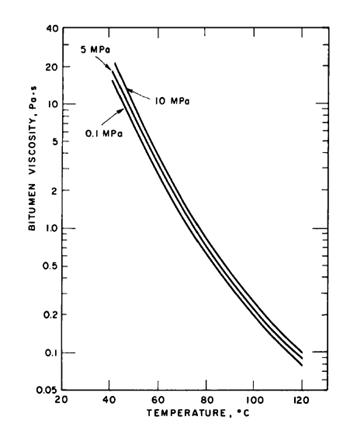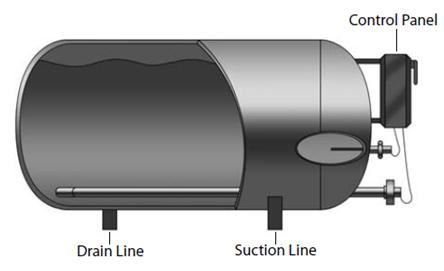Bitumen Heating
August 2, 2019
WHY IS IT WORTHWHILE TO HEAT BITUMEN ELECTRICALLY?
INTRODUCTION
 Figure 1 – Bitumen flow by gravity is very sluggish in cold weather
Figure 1 – Bitumen flow by gravity is very sluggish in cold weatherBecause of the growing importance of heavy oil, bitumen and asphalt, new techniques must be applied to process them. A basic challenge is to make them flow: from the reservoir to the refinery; from one station of the refinery to the next; from a depot tank to a truck or a railway car, among other situations.

Figure 2 – Effect of temperature on the viscosity of gas-free Athabasca (ARC) bitumen at constant pressure [1]
The extremely high viscosity shown for Athabasca bitumen in Figure 2 is typical of all bitumen – for reference, the viscosity of water is 8.9 x 10-4 Pa-s. Also typical is the observed tendency of the viscosity to decrease exponentially with temperature.
In this article, we demonstrate quantitatively the importance of heating heavy oil products before pumping. For convenience, we will simply use the term bitumen to designate all the heavy oil products described above.
DEPENDENCE OF PUMPING POWER ON TEMPERATURE
The power P required to pump bitumen at a flow rate Q across a pipe in which the pressure drop is Δp is given by:
(1)
The pressure drop in turn, is proportional to the friction factor f, the ratio of pipe length l to diameter d, and the dynamic pressure ρV2/2, where ρ is the density and V the velocity:
(2)
As bitumen is extremely viscous, the flow is laminar and we have the familiar expression for the friction factor, f = 64/Re where Re is the Reynolds number
(3)
The flow rate Q is related to the pipe diameter d and velocity V by
(4)
Substituting from equations 2, 3 and 4 into 1, we obtain for the power the expression
(5)
In equation (5), we see that the pumping power is directly proportional to the temperature-dependent viscosity. A calculation with equation (5) and the viscosity data of Figure 2 illustrates the impact of heating, Table 1.
| Effect of Temperature on Pumping Power of Bitumen |
|||
| CONDITIONS | |||
| Volume flow rate: | 250 barrel/hour | ||
| Pipe diameter: | 3 in | ||
| Pipe length: | 500 ft | ||
| Bitumen density | 63.05 lb/ft3 | ||
| Velocity | 7.94 ft/s | ||
| CALCULATED PUMPING POWER VS. TEMPERATURE | |||
| TEMPERATURE | VISCOSITY, PA-S | PUMPING POWER, kW | |
| oC | oF | ||
| 40 | 104 | 17 | 382.0 |
| 60 | 140 | 2.8 | 62.9 |
| 80 | 176 | 0.6 | 13.5 |
| 100 | 212 | 0.2 | 4.5 |
Table 1 – Huge savings in pumping power are obtained by heating bitumen
Pumping power essentially decreases twenty-five-fold, from 382 kW to 13.5 kW, by heating the bitumen from 40 oC to 80 oC.
It should be pointed out that there is a savings not only in pumping power, but in capital cost, as a 13.5 kW pump costs but a small fraction of a 382 kW pump.
TECHNIQUES FOR ELECTRICAL HEATING OF BITUMEN

Figure 3 – Cross-section of a bitumen tank with electrical pipe heater.
Several techniques are used to heat bitumen. Electrical heating is a prime choice because of its precision, uniformity and compactness, among other qualities. Common arrangements are:
· An immersion-type tank flange heater, comprising several metal-sheathed resistance heating elements in direct contact with the bitumen. The bitumen is heated and circulates by natural convection inside the tank;
· A circulation heater. Here the flange heater is inside a circulation vessel fitted with inlet and outlet connections; heat transfer to the bitumen occurs by forced convection;
· A pipe heater, one in which the heating elements are enclosed in a pipe and thereby shielded from direct contact with the bitumen as seen in Figure 3. This arrangement may be preferred in case of extreme viscosity.
In general, all bitumen must be considered as a flammable liquid or presenting the danger of an explosion in case of excessive heating. The maximum storage and handling temperature corresponds to the flash point, i. e. the temperature at which the vapor above which a liquid will catch fire in the presence of air and of a source of flame. This temperature varies according to the quality; a typical value is 450 oF. Accordingly, it is recommended that bitumen heaters have an explosion-proof (NEMA 7) enclosure.
NOMENCLATURE
| NAME | SYMBOL | ENGLISH UNIT | SI UNIT |
| Density | ρ | lb/ft3 | kg/m3 |
| Friction factor | f | (dimensionless) | |
| Pipe diameter | d | in | m |
| Pipe length | l | ft | m |
| Power | P | HP | kW |
| Pressure drop | Δp | psi | kPa |
| Reynolds number | Re | (dimensionless) | |
| Velocity | V Q | ft/s | m/s |
| Volume flow rate | barrels/hour | m3/s | |
